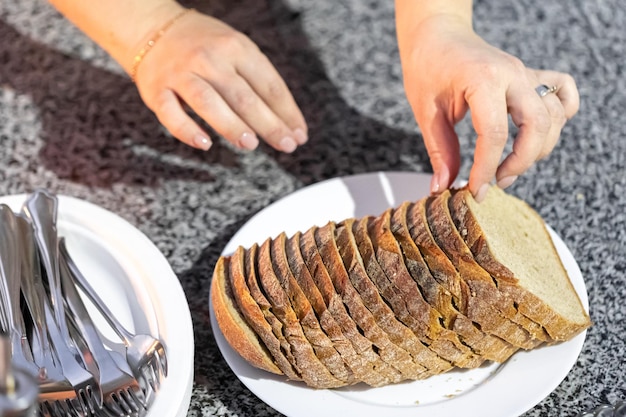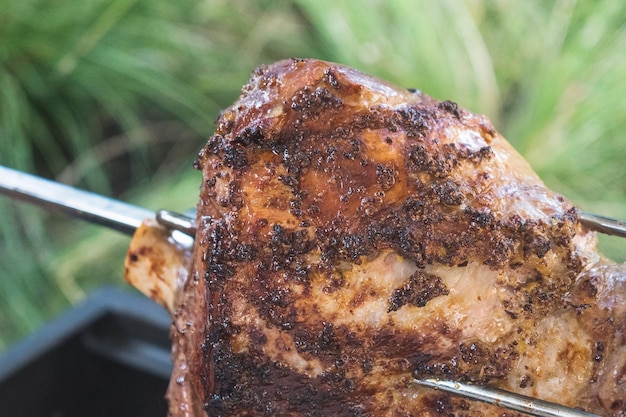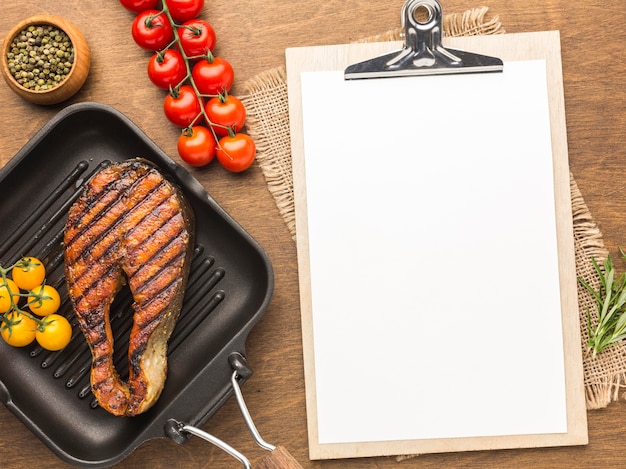There's something undeniably special about a standing rib roast. It's a dish that screams celebration, a centerpiece that commands attention, and a promise of pure, unadulterated deliciousness. But let's be honest, tackling a roast can seem a bit daunting. Getting it just right, with a perfect balance of tenderness and flavour, takes a bit of know-how. That's where this guide comes in. I've spent years perfecting my roast game, and I'm ready to share all my secrets, from choosing the right cut to nailing the cooking time. So, grab your apron, fire up the oven, and let's embark on a culinary adventure that will leave you feeling like a true roast master.
(Part 1) Unveiling the Masterpiece: The standing rib roast

Before we dive into the cooking details, let's take a moment to appreciate the star of the show – the standing rib roast. This isn't just any cut of meat; it's a majestic combination of prime ribs, all nestled together, bone-in, and ready to transform into a culinary masterpiece. The bone itself is a crucial ingredient, adding a depth of flavour and ensuring a moist, succulent outcome. Think of it as a tiny oven inside the roast, conducting heat and locking in deliciousness.
1. The Bone-in Advantage: A Flavour Symphony
Why bother with a bone-in roast? Because it's a game-changer. The bone acts as a natural conductor, distributing heat evenly throughout the roast and preventing it from drying out. The result is a beautifully cooked, juicy, and tender piece of meat. But the benefits don't stop there. The drippings that gather around the bone during cooking? Pure culinary gold! Those rich, flavorful juices are the key to creating the most incredible gravy. You'll be scraping the pan clean for those precious drippings.
2. The Prime Time: Understanding Beef Grades
Now, you might be wondering, "What exactly is 'prime'?" It's not just a fancy term, it's a specific USDA grade that signifies the quality of the beef. Think of it as a ranking system for deliciousness. The higher the grade, the more marbling (fat) the meat has. And that marbling is the key to flavour and tenderness. So, what are your options?
- Select: This grade is lean, with less marbling. It can be a bit dry, but it's a good option if you're watching your fat intake.
- Choice: This grade strikes a balance between leanness and marbling, offering a good amount of flavour and tenderness.
- Prime: This is the cream of the crop, with the most marbling and the richest, most tender flavour. It's also the priciest, but if you're going for the ultimate indulgence, prime is the way to go.
My personal preference? I go for prime whenever possible. It's like the luxury car of beef – it's worth every penny. But if you're on a budget, a choice roast will still deliver a delicious meal.
(Part 2) Decoding the Cooking Time: A Guide to Success

Alright, we've got our star ingredient, but how do we cook it to perfection? That's where the art of understanding cooking time comes in. There's no magic number here, it depends on a few crucial factors.
1. The Weight Factor: A Crucial Calculation
The first thing to consider is the weight of your roast. It's a simple equation: a larger roast takes longer to cook than a smaller one. So, grab your trusty kitchen scale and weigh your roast. Don't worry about being super precise; a good estimate will do the trick.
2. The Temperature Tango: Achieving Your Desired Doneness
Everyone has their preferred level of doneness, from a rare and juicy centre to a well-done, cooked-through piece of meat. It's a matter of personal preference, but it's crucial to understand the internal temperature that corresponds to your desired outcome.
| Doneness | Internal Temperature (°F) |
|---|---|
| Rare | 125-130 |
| Medium Rare | 130-135 |
| Medium | 140-145 |
| Medium Well | 150-155 |
| Well Done | 160 |
My personal sweet spot is medium-rare. It's pink and juicy, with just a hint of redness in the center. But ultimately, it's up to you!
3. The Oven's Influence: Adjusting for Heat
The oven temperature you choose will have a direct impact on the cooking time. A higher temperature will cook the roast faster, but you run the risk of drying it out. A lower temperature will take longer, but it will result in a more tender, juicy roast.
I've found that 325°F (160°C) is the sweet spot for a standing rib roast. It's hot enough to get the roast sizzling and create a beautiful crust, but it's also gentle enough to ensure even cooking and a juicy outcome.
(Part 3) The Cooking Process: A Step-by-Step Guide

Now, we're ready to get cooking! This is where the magic happens. Here's my tried-and-true method for creating a show-stopping roast that will leave everyone impressed.
1. The Art of Seasoning: A Symphony of Flavors
Before we put the roast in the oven, let's give it a good rub-down with some flavour. I like to keep it simple with salt, pepper, and a touch of garlic powder. But feel free to experiment with different herbs and spices to suit your taste. Rosemary, thyme, paprika, and even a little bit of chili powder can add amazing depth to the roast. Remember, a little goes a long way, so don't go overboard!
2. The Roasting Ritual: Patience is a Virtue
Place the seasoned roast on a roasting rack set inside a baking pan. This allows for air to circulate around the roast, preventing it from steaming and helping it cook evenly. Pop it into your preheated oven, set a timer, and prepare to be patient.
Here's a general guideline for cooking time based on the weight of your roast:
- 3-4 pounds: 1 hour 15 minutes to 1 hour 45 minutes
- 5-6 pounds: 1 hour 45 minutes to 2 hours 15 minutes
- 7-8 pounds: 2 hours 15 minutes to 2 hours 45 minutes
- 9-10 pounds: 2 hours 45 minutes to 3 hours 15 minutes
These are just general guidelines. The best way to ensure your roast is cooked to perfection is to use a meat thermometer. Insert the thermometer into the thickest part of the roast, making sure it doesn't touch the bone.
3. The Resting Ritual: A Key to Tenderness
Once the roast reaches your desired internal temperature, it's time for a well-deserved rest. Take it out of the oven and tent it loosely with aluminium foil. This helps trap the heat and moisture, preventing the roast from cooling too quickly.
Why rest? Because it's the secret to melt-in-your-mouth tenderness. As the roast rests, the muscle fibres relax, allowing those flavorful juices to redistribute throughout the meat. Think of it as a juicy homecoming.
How long should you rest the roast? Aim for at least 15 minutes per pound. So, a 5-pound roast would rest for 75 minutes.
4. The Slicing Ceremony: A Feast for the Eyes
After the roast has rested, it's time for the grand finale – the slicing. Use a sharp carving knife and slice the roast against the grain. This helps to break down the muscle fibres and make the meat even more tender. Arrange the slices on a beautiful platter and drizzle generously with the pan drippings, creating a symphony of flavour.
(Part 4) The Art of Resting: Achieving Maximum Tenderness
We've touched on resting, but let's dive deeper into this crucial step. Resting is more than just a pause; it's a vital element in transforming your roast into a culinary masterpiece.
1. The Science of Resting: Understanding the Process
Imagine your roast as a group of muscle fibres tightly wound together. When you cook the roast, those fibres contract, squeezing out those precious juices. Resting allows those juices to seep back into the meat, rehydrating it and making it incredibly tender.
Think of it as a reverse squeeze. The muscle fibres relax, and the juices flow back in, transforming a potentially dry roast into a juicy, succulent delight.
2. Mastering the Resting Ritual: Tips and Tricks
Here are a few tips to ensure your roast rests like a pro:
- Cover it Up: Tenting the roast with aluminium foil helps trap the heat and moisture, preventing it from cooling down too quickly.
- Time is of the Essence: The golden rule is to rest the roast for at least 15 minutes per pound.
- Keep it Warm: If you're worried about the roast getting cold, you can place it in a preheated oven set to the lowest temperature. Just make sure the oven is turned off before you put the roast inside.
Resting might seem like a small detail, but it makes a world of difference. So, don't skip this crucial step in your roast journey!
(Part 5) A Symphony of Flavors: Elevating Your Roast with Sides
A standing rib roast deserves a supporting cast of delicious side dishes. Think of it as a culinary symphony, where each dish adds its unique flavour and texture, creating a harmonious and unforgettable experience.
1. Potato Perfection: Creamy, Crispy, and Cheesy
Potatoes are the ultimate roast companion. They provide a comforting and satisfying counterpoint to the richness of the beef. You can go for creamy mashed potatoes, crispy roasted potatoes, or even a cheesy potato gratin.
I love the simplicity of roasted potatoes, tossed with olive oil, salt, pepper, and a touch of rosemary. They come out beautifully crispy on the outside and fluffy on the inside, perfectly complementing the roast.
2. Green Delights: Fresh and Flavorful
Green vegetables add a refreshing touch to the meal, balancing out the richness of the roast. roasted asparagus with a squeeze of lemon, sauteed green beans with garlic and herbs, or a simple side salad with a tangy vinaigrette are all excellent choices.
3. Gravy Goodness: The Essence of Flavour
No roast is complete without a generous ladle of gravy. The drippings from the roast are pure flavour gold, and they're the key to creating a truly exceptional gravy. Just scrape up those drippings from the roasting pan, add some flour and broth, and simmer until you have a smooth, rich sauce.
A good gravy elevates the entire meal, bringing all the flavours together in perfect harmony.
(Part 6) Beyond the Oven: Exploring Different Cooking Methods
While oven roasting is the classic method, there are other techniques you can explore to add variety and excitement to your roast game.
1. The dutch oven's Embrace: Slow and Low Cooking
A Dutch oven is a fantastic tool for creating a slow-cooked, ultra-tender roast. Its thick walls and tight-fitting lid create a moist and even heat environment, allowing the roast to cook gently and develop intense flavour.
Just brown the roast on all sides in the Dutch oven, then add some vegetables and broth, cover tightly, and cook in a low oven for several hours. The result is a roast that practically melts in your mouth.
2. The Grill's Sizzle: A Smoky Delight
For a bold, smoky flavour, try grilling your standing rib roast. It's a great option for outdoor gatherings, adding a touch of rustic charm to your meal. Just be sure to use a grill with consistent heat distribution and a meat thermometer to ensure even cooking.
You can grill the roast directly over medium heat or indirectly over low heat, depending on your preference. A little bit of smoke adds a whole new dimension of flavour.
3. Sous Vide Precision: The Ultimate Control
sous vide cooking is a method that involves sealing the roast in a vacuum-sealed bag and immersing it in a temperature-controlled water bath. This technique provides incredibly precise temperature control, ensuring even cooking and a perfectly juicy outcome.
Sous vide cooking might sound complicated, but it's actually quite simple. Just place the sealed roast in a water bath set to your desired internal temperature and let it cook slowly and evenly. Then, you can sear the roast for a crispy crust before serving.
(Part 7) FAQs: Answering Your Roast Questions
You might have some burning questions about roasting. "What if I overcook it?" or "How long can I keep it in the fridge?" Let's address those common concerns and provide some helpful answers.
1. Overcooked Roast: A Culinary Disaster Averted
Overcooking a roast is a common fear, and rightfully so. It can lead to a dry and tough piece of meat. The best way to prevent overcooking is to use a meat thermometer and check the internal temperature regularly.
If you do happen to overcook the roast, there are a few things you can do to salvage the situation. First, try adding a bit of broth or pan drippings to the roasting pan and continue cooking at a lower temperature. This will help rehydrate the meat. You can also slice the roast thinly and serve it with a rich gravy to help mask any dryness.
2. Roast Prep Ahead: A Feast of Convenience
You can definitely cook a roast the day before serving. Just let it cool completely and refrigerate it overnight. The next day, reheat it in a preheated oven at 325°F (160°C) for about 30 minutes, or until heated through.
Reheating a roast can sometimes lead to a slightly drier texture, so make sure to baste it with pan drippings or broth during reheating to maintain moisture.
3. Refrigerator Rules: Storing Your Roast
A cooked standing rib roast can be stored in the refrigerator for up to 3-4 days. Just wrap it tightly in plastic wrap or aluminium foil to prevent it from drying out.
4. Reheating Ritual: Bringing Back the Flavour
As mentioned earlier, the best way to reheat a roast is to place it in a preheated oven at 325°F (160°C) for about 30 minutes. You can also reheat it in the microwave, but it might not be as tender.
If you're reheating a roast that has been stored in the refrigerator, it's a good idea to add a little bit of broth or pan drippings to the roasting pan to help rehydrate the meat.
5. The Art of Carving: A Symphony of Slices
Carving a standing rib roast is a bit of an art form. Use a sharp carving knife and slice the roast against the grain. This will make the meat more tender and easier to chew. Make thin, even slices and arrange them on a beautiful platter.
Carving a roast can be a little intimidating, but with practice, you'll become a pro in no time.
(Part 8) Final Thoughts: Embracing the Roast Journey
Cooking a standing rib roast is more than just a recipe; it's a journey of culinary discovery. It's about embracing the process, taking your time, and enjoying the satisfaction of creating a truly special dish.
Don't be afraid to experiment and find what works best for you. This guide is just a starting point. As you gain experience, you'll develop your own techniques and preferences. And remember, the most important ingredient of all is a love for good food and the joy of sharing it with others. Happy roasting!
Everyone is watching

Corn on the Cob: The Ultimate Guide to Perfectly Cooked Ears
Healthy MealsAh, corn on the cob. Just the name evokes images of sunny days, barbecues, and that sweet, juicy flavour that ...

Perfect Pork Roast Oven Cooking Time: A Guide to Delicious Results
Healthy MealsThere's something truly satisfying about a perfectly roasted pork. The aroma alone is enough to make your mout...

Ham Cooking Time: How Long to Bake, Smoke, or Boil a Delicious Ham
Healthy MealsAh, ham. It's a classic, isn't it? A real crowd-pleaser, especially around holidays. And when done right, it'...

Scallops: The Ultimate Guide to Perfect Cooking
Healthy MealsAh, scallops. Those delicate, sweet, and utterly delicious morsels of the sea. They hold a special place in my...

Spaghetti Squash: The Ultimate Guide to Cooking and Serving
Healthy MealsRemember that time you saw spaghetti squash at the supermarket, looking all bumpy and strange, and thought, "W...
